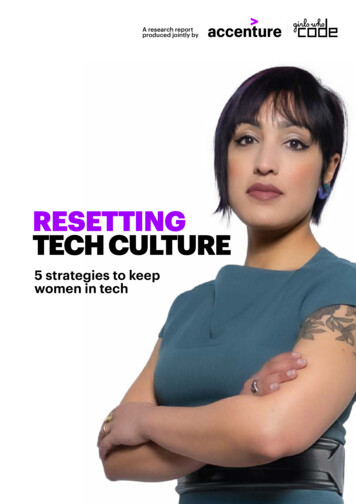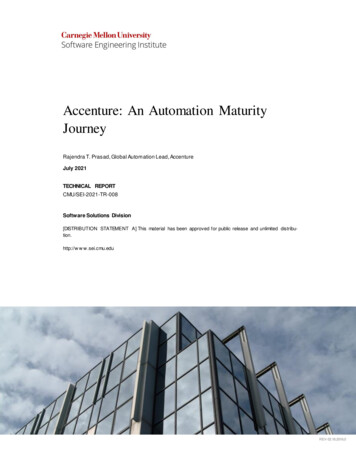
Transcription
A research reportproduced jointly byRESETTINGTECH CULTURE5 strategies to keepwomen in tech
TECH NEEDS WOMENWe want to double the number of women in tech.To help them thrive, we’ll need to change.EXECUTIVESUMMARYWomen have almost caught up to menin the fields of technology,engineeringand mathematics, right? You mightassume so—but they have actuallyfallen further behind at the verymoment when tech roles are surgingand vital to the U.S. economy and itscontinued leadership around theglobe. Unbelievably, the proportion ofwomen to men in tech roles hasdeclined over the past 35 years. Andhalf of young women who go into techdrop out by the age of 35.But we’ve cracked the code for reversingthis troubling trend. We’ve found that aninclusive culture—one that is not onlydiverse on paper, but that enables everyone tohave a voice—is the master key that unlocksopportunities for women who are studying andworking in technology.Our survey of students, employees,senior HR leaders and human resourcesofficers (SHROs*) reveals the specificenvironmental characteristics that willhelp women in tech advance and thrive.The differences between the most andleast inclusive environments are huge. Inless-inclusive colleges, one in four womenfeel like an outsider. Just one in 20 womenfeel that way in more-inclusive colleges.And in less-inclusive workplaces, thelikelihood that a woman will advanceto manager is just 28%, compared with40% for men. That gender differencedisappears in more-inclusive workplaces.Tenley & Jasmin —Senior Tech Analysts2 CULTURE RESETWomen of color and Lesbian, Bisexual andTransgender (LBT) women typically face evensteeper barriers in tech—however, theseintersectionality effects are also mitigatedby culture. For example, in less-inclusivecollege environments, just 67% of womenof color see a clear pathway from studyingtech, engineering or math to a related career,compared with 79% of other women. Inmore-inclusive environments, this figure jumpsto 92%, on par with other women. In theworkplace, 83% of LBT women in more-inclusive cultures say they love their jobs,compared with just 35% of their peers workingin less-inclusive organizations. And in moreinclusive workplace cultures, the likelihood ofwomen advancing to manager and beyondby age 30 increases by 61%; for women ofcolor it increases by a staggering 77%.Our survey also revealed a disconnect betweenwhat women experience on the ground andwhat senior HR leaders believe about theirorganizations. HR leaders tend to think theculture in their organization is more supportiveof women than it actually is. They are (at 45%)twice as likely as women (at 21%) themselvesto say it’s “easy for women to thrive in tech.”They also are not yet convinced aboutthe power of culture as much as ourresearch indicates they should be. Just38% identify building a more-inclusive cultureas an effective means to retainand advance women in tech roles.Not surprisingly the perception gap betweenleadership and employees goes beyond justwomen in the tech industry. Recent globalresearch by Accenture, “Getting to Equal 2020:The Hidden Value of Culture Makers,” surveyedmen and women across a variety of industriesand found that two-thirds of leaders (68%) feelthey create empowering environments wherepeople have a sense of belonging, yet just onethird (36%) of employees agree.A widespread cultural reset would help us todrive much-needed change: Our analysissuggests that if every company scored high onmeasures of an inclusive culture—specifically,if they were on par with those in the top 20%of our study—the annual attrition rate ofwomen in tech could drop by up to 70%.If this were to happen we could see up to3 million young women working in techin 2030, 1.4 million more than therewill be if current trends continue.Our action items for colleges and companiescan help leaders reprogram their organizationsfor inclusion and success, starting today.*This report draws on data from three surveys conducted betweenFebruary and July 2019:· 2,700 college students· 500 senior human resource leaders· 1,990 tech workers aged 30 or belowSee appendix for more detail.CULTURE RESET 3
TWO STEPS BACK?It’s a startling truth: In spite of the effortsmany have made in the last decade towardencouraging girls and women to pursuetechnology careers, the percentage of techworkers who were women in 1984 (35%)was actually higher than it is today (32%)1.Although the absolute number of women intech roles has increased significantly over thatsame time frame (from 1.6M to 3.7M)2, the factthat the gender imbalance is greater than it was35 years ago is shocking and damaging—bothfor women and for the health of our economy.What does this striking techgender imbalance look like? Women hold just 16% of engineering rolesand 27% of computing roles in companiesin the US3. Women leave tech roles at a 45% higherrate than men4. 50% of women who take a tech roledrop it by the age of 35, compared toapproximately 20% in other types of jobs5. In the largest 1,000 companies, fewer thanone out of five Chief Information Officers(CIOs) or Chief Technology Officers (CTOs)are women6.Are leaders seeing thewhole picture?While there are several factors in play, oursurvey reveals a critical disconnect: Onlyabout half of the women we surveyed believethe company culture where they work isempowering. But when we asked SHROs thesame question, more than three-quarters ofthem said their company culture enableswomen to be successful in technology roles. SHROs are (at 45%) twice as likely aswomen (at 21%) themselves to say it’s“easy for women to thrive in tech.” SHROs are almost three times morelikely to describe the path of womenof color as “easy” compared withwomen of color themselves.4 CULTURE RESETSHROs (along with the rest of the C-suite) areoften change makers in their organizations.Many want to effect even greater change. Goodintentions notwithstanding, our survey showsthat leaders might not be fully in touch withwhat workers on the ground are experiencing,especially as their own responsibilities multiply.They might not have the tools or knowledgethey need to foster real cultural change.The very vibrancy of our economy is at risk.As tech permeates every industry moreeach day, rebuilding tech culture becomesmore of an imperative if the U.S. is to remaina world leader in tech—and in general.Our research shows how a culture resetcould change the game for women intech and potentially double the numberof young women working in the industryby 2030. We have actionable solutionsfor building an inclusive culture wherewomen—and everyone—can thrive.50%Current landscape for women who want topursue a career in technologyCollegeWorkplaceLeadershipOnly 25% of techgraduates arewomen, with a dropout rate of 37% fortech classes vs. 30%for other programs.Percentage ofwomen in techroles has droppedfrom 35% in 1984to 32% in 2018.Women are 2.5x morelikely to drop techroles than other rolesbefore 35. Womenrepresent only18% of CIO/CTOs.WOMENNEED MOREOPPORTUNITIES.NOW.of women whotake a tech roledrop it by theage of 3520compared to%in other typesof jobsSonali, R&D Manager in Tech,Girls Who Code InstructorCULTURE RESET 5
PART 1: WHY THETECH GENDERIMBALANCEMATTERSEvery company is—or is fast becoming—atechnology enterprise. From simply havinga website to using a digital paymentsystem, deploying an AI-enabled chatbot ordesigning a self-driving car, all organizationshave to engage with technology.As a result, many companies have had torebalance the skills they need to operate.7Take the banking industry: At JPMorgan,around 50,000 of its employees—20% of itsentire workforce—are now technologists; atGoldman Sachs that figure is 25%.8 Both banksnow self-define as “technology groups.”9The labor market is struggling to keep pacewith this demand, especially as technologyevolves. For example, there is outstandingdemand for an estimated 314,000cybersecurity experts in the U.S.10 —a rise of50% since 2015—and 150,000 data scientists.11Over the last three decades, computingroles in the U.S. have grown 10 times fasterthan the average growth of all job roles.The gender gap also matters becausegreater diversity has been linked withdriving innovation12, reducing bias andraising tech company share prices.13Innovation equals survival for companies inthe age of disruption. Our previous research,“Getting to Equal 2019: Creating a Culture thatDrives Innovation,” shows that the innovationmindset is six times higher in the most-equalcultures than in the least-equal ones.When the teams designing, developing anddeploying new technologies are not diverse,bias inevitably creeps in: For instance, a lackof “female” crash test dummies contributes tothe fact that women involved in car crashesare 47% more likely than men to be seriouslyinjured, and 17% more likely to die.14“Digital-era technology, whichbegan as a differentiatingadvantage years ago, is nowexpected from every business.It won’t be long before the standoutexamples of today are the norm.The message is clear: Keeping upwith the digitals won’t cut it forwhat’s coming next.”Accenture Tech Vision 2019U.S. job demand growth since1990:338A diverse world needs techmade by diverse peopleAnd although emerging technologies such asfacial recognition offer enormous potential,concerns over their accuracy and use havegrown during recent racial injustice protests,leading to Amazon pausing use of its services.15Increasing the number of women and peopleof color in the development and roll-out ofsuch technologies could boost public trust.A recent study by the Stanford GraduateSchool of Business found that greatergender diversity raises tech companyshare prices.16 In fact, a full 91% of theSHROs in our survey told U.S. that attractingwomen with tech experience/educationis critical for their company’s success.The benefits of increasing the number ofwomen in tech extend well beyond businessperformance, though. Doing so would havea significant impact on the gender pay gap,for example. In the U.S., women’s medianearnings overall are approximately 80%of men’s. Tech roles pay above averageat every education level; in computing,women’s earnings climb to 87% of men’s.17Comparisons to men aside, there areclearly more opportunities for women to beemployed and to achieve financial successif they go into tech instead of other fields:Median salaries for tech roles are abouttwice as high as those for other roles.%Computingroles34%All jobrolesOUR DIFFERENCESTRANSLATE INTOIMPACT, NOTLIMITATIONBritney, Blockchain Partnershipsand Investments Lead, TechMentor, Speaker and Influencer6 CULTURE RESETCULTURE RESET 7
PART 2: WHY THEREGRESSION?COLLEGE ANDWORK CULTURESAREN’T INCLUSIVEENOUGHHow are we moving backwards, whatwith all the emphasis leaders andorganizations have put on gettinggirls and young women into tech?It’s not the subjects or skillsthemselves: It’s about theenvironments in which girls andwomen study, and then work, in tech.The report “Getting to Equal 2018: Creatinga Culture Where Everyone Thrives,” identified40 factors that help women of all ages, acrossall job roles, sectors and geographies, to thrive.This study identifies the factors that help youngwomen (30 and below) in tech roles in theU.S. only.*These environments are the antithesis of the“bro culture” rife in the tech world (and aptlydescribed by activists such as Ellen Pao,author of Reset: My Fight for Inclusion andLasting Change).Our current analysis confirms this previousfinding and identifies culture as a vital factor inattracting and retaining women in tech.At the start of this project Girls Who Codeasked this question: What kind of a world arewe sending our young tech students into? Andis it one where they can thrive? And the answeris, it depends. It depends on the college theygo to and on the company they join.One of these worlds represents the crèmede la crème: Its colleges with tech programsand offices with tech jobs make women feelencouraged, safe, free to be creative—and freeto be themselves.The other world represents less-than-idealscenarios: Its colleges and offices are placeswhere women feel overlooked, discriminatedagainst and discouraged by the lack offlexibility as well as the dearth of role models.WE NEED TOSHOW WOMENTHAT WE’RECAPABLE OFANYTHINGIn real life, colleges and workplaces fallsomewhere along a big spectrum. But imaginingthe two extremes helps underscore the effect ofculture on the gender tech imbalance. Becauseculture, it turns out, is what largely determineswhether women thrive in technology-focusedacademic programs or jobs.“I’m not your average typical‘techie,’ but after Girls Who Codegave me a sense of how to thinkwhen you’re doing computerscience, my ambition has alwaysbeen to do something in tech.”Engineer at Tech ConsultancyFor that study, we identified 40 cultural factors that supportwomen’s advancement in all roles, not just in technology ones.Women in college are much more likelyto persist with tech programs if they feelcomfortable and supported in their classroomexperience. Meanwhile, women who leavetech roles in the workforce, or who are likely toleave in the near future, identify a non-inclusivecompany culture as the major driver.Jasmin,Senior Tech Analyst,UI/UX Innovator, Presenter8 CULTURE RESETCULTURE RESET 9
PART 3: HOW WE DEFINE AN‘INCLUSIVE’ WORKPLACE CULTUREOver the past three years, we have surveyedover 70,000 employees around the worldin our Getting To Equal research series. Thishas allowed us to identify—and quantify thestrength of—the factors that impact theability of women (and everyone else) tothrive in the workplace. We use the presenceand strength of these factors to determinehow ‘inclusive’ a workplace culture is.Building on this methodology, this reportassesses how inclusive colleges andworkplaces are in the United States—for techstudents and employees, respectively.YOU WANTTO BEEMPOWEREDTO MAKEDECISIONSAND TO LEADIdentifying best practicesThroughout this report we cite two coreanalysis segments: “more-inclusive” and “lessinclusive.” In the workplace, we identified thefactors that positively and significantly influencethe ability of women to thrive in tech; in college,we adapted our method to allow for reducedcertainty of an enjoyable college experiencenecessarily leading to a related job role.At work: We used a linear regression model toanalyze responses to our survey to identify thecultural factors that positively and significantlyinfluence the (likely) retention/advancement ofwomen in core programs/roles. These factorswere grouped into three buckets: Boldleadership; Comprehensive action; andEmpowering Environment: respectand autonomy.At college: We identified the questions relatingto college culture to understand theexperiences of women and men, where theirexperiences did and did not align, and whatfactors made the most difference. Thesequestions included diversity of faculty/studentbody; gender equality; ethnic/racial minoritysupport; sexual harassment and discrimination;and freedom to "be yourself" at a college.We scored every respondent on the incidenceand strength of these factors in their collegeor workplace to produce a respondent-specificculture score. We then segmented andanalyzed the responses of the top 20%(“more-inclusive”) and the bottom 20%(“less-inclusive”) in both college and theworkplace independently.For more detail, please see the appendix.BOLD LEADERSHIPA diverse leadership team that providesrole models and publishes targetsThe culturalfactors that helpwomen thrive in thetech workplaceCOMPREHENSIVE ACTIONPolicies and practices designed tolevel the playing fieldEMPOWERING ENVIRONMENTRespect:Employees are treated like humans; diversityand individuality actively encouragedAutonomy:Employees are given flexibility and control overhow, when and where they workTenley, Sr. Cloud andData Science Analyst,GWC Teaching Alumna10 CULTURE RESETCULTURE RESET 11
PART 4: A TALE OF TWOCOLLEGE CULTURESThe tech gender imbalance starts early: In our 2016 report Cracking the GenderCode, we found that girls’ interest and enjoyment in tech wanes in high school asthe availability of computing classes declines and they lose friends in class andbegin to feel isolated.Many women never rediscover their interestin tech, shrinking the number who apply fortech programs at college; for example, just28% of students taking Advanced PlacementComputer Science exams in 2018 were women.18And many of those who do make it to collegeWomen’s college experiencesSee a clear pathway from studiesto a careerFeel they belongPlan to look for a tech role after collegeFeel comfortable asking questionsFeel like an outsider12 CULTURE RESETprograms don’t stay there. We estimate that37% of women switch away from tech majors,compared with 30% on average across alldegrees.19 The upshot is that just one in fourtech graduates in the U.S. today are women.20In more-inclusivecollege cultures938985835%%%%%Using our tech student survey data, we builta model to identify the factors that influencethe likelihood of women pursuing a techcareer at different stages of their college lives.We found that studying in a more-inclusivecollege culture has a strong impact on awoman’s decision to look for a job in tech,ranging from making it 21% more likely infreshman and sophomore years to 19% and14% in the junior and senior year, respectively.Men also benefit in a more-inclusive culture,with 88% planning to look for a tech role aftercollege vs. only 69% in a less-inclusive culture.37%of women switch awayfrom tech majorsIn less-inclusivecollege cultures7337644625%LIKE-MINDEDPEOPLE WON’TPRODUCEANYTHINGNEW%%%%Batool, Senior atUC Berkeley, GWCProgram ParticipantCULTURE RESET 13
Inclusive culturessupport diversityOf course, not every woman has the sameexperience, regardless of where shegoes to college. Race and sexuality canhave intersectional effects on students.In fact, in less-inclusive colleges, apecking order emerges when it comesto be being able to thrive in tech: men,women, and then women of color.Among women of color at less-inclusivecolleges in our survey, for instance, 55% foundclasses “inspiring,” versus 67% of other women.Women of color are also three times more likelyto experience racial harassment and two anda half times more likely to experience racialdiscrimination compared to other women.These issues affect the likelihood that womenof color will pursue tech careers: Just 67% ofthose in less-inclusive environments see a clearpathway from studying tech, engineering ormath to a career (vs. 79% of other women).But in more-inclusive environments, this figurejumps to 92% (vs. 94% of other women). Andin more-inclusive colleges, close to 90% ofwomen of color find their classes to be both“inspiring” and “friendly”; the samepercentage as for other women.Women of color in college tech programs aremore likely to participate in women’s networksthan other women in tech at the same school(63% vs. 50%), an indication that they areseeking out support that is otherwise missing.Lesbian, Bisexual and Transgender (LBT)women who major in tech also have amore positive experience in more-inclusivecultures. For example, 90% of LBT womenin more-inclusive environments “love” theirclasses compared with just 61% in lessinclusive environments; and 83% feel theyhave the freedom to be themselves (vs.46% in less-inclusive environments).But even in more-inclusive college cultures,the experiences of LBT women lag behind theirnon-LBT peers. While 76% of LBT women inthese environments feel they“belong” and are “comfortable askingquestions,” the figure rises to 86% for otherwomen. And two-thirds of LBT women haveexperienced some form of harassment,compared with half of non-LBT students.SPOTLIGHT: COLLEGE LOOPSGirls Who Code—the international nonprofit leading efforts to close thegender gap in tech—runs multiple programs aimed at bringing more girlsinto the technology workforce. In 2020, the organization had 80,000college-aged alumni and that number is only growing. Half of themcome from historically underrepresented groups—Black, Latina,low-income—in tech.To support these alumni and ensure they persist in the field, theorganization launched College Loops—university-level networks of alumniand other young women in computer science. They are led by Girls WhoCode alumni and are open to any women who are studying computing orinterested in technology.And because community colleges are an untapped resource for increasingdiversity in computer science (over 50% of Hispanic and Blackundergraduates are educated at community colleges)Girls Who Code debuted College Loops at both fouryear and two-year institutions.Today, Girls Who Code has 200 College Loops oncampuses across the United States.The organization’s college-aged alumni aremajoring in computer science at a rate 15 timesthe national average. And the group is ontrack to close the gender gap in entry-leveltech jobs by 2027.SPOTLIGHT: "SUNITA"Sunita was wary of pursuing computer science at college; she hadvery real fears about not being accepted and not having friends in theclassroom. However, she connected with the female head of the computerscience department at John Hopkins University, who began to mentorher. She also joined the Women in Computer Science campus group, andultimately gained the courage to pursue the path she wanted from the start.Having been put off by the types of software engineering roles presentedto her at college, Sunita initially applied for non-tech roles. She somewhatreluctantly landed a software developer role at a start-up, and acceptedit, thinking she would only stay for a year. But the role has exceededher expectations; she loves the flexibility to work when, where and howshe wants, and describes the founders as “approachable, open andsupportive.” Sunita now sees herself staying in tech, either in a managerialor hands-on specialist engineering role.14 CULTURE RESETA WOMANIN THE ROOMMEANS THATTHE PATHHAS ALREADYBEEN CARVEDEsra, Product Innovations in TechCULTURE RESET 15
PART 5: A TALE OF TWOWORKPLACE CULTURESWhat happens when young womenleave the college campus and join theworld of work?The workplace culture of the place where theyland matters: Women plan to leave tech forvarious reasons, but in our study we foundthat poor company culture accounts for 37%of those—making it the number one cause.By contrast, dissatisfaction with the job roleWomen’s workplace experiencesLove their jobBeen promotedLikelihood of advancing to managerColleagues assume they are morejunior than male peersMade to feel that the job is not for"people like them"Have heard or read inappropriateremarks or commentsLikelihood of leaving tech16 CULTURE RESETMore-inclusive cultureshelp women thriveaccounts for 31% of reasons for leaving; thedraw of another role (outside tech) for 22%;and a lack of diversity for 10%. When askedhow companies could attract more people likethem into tech roles, 51% of women identifiedworkplace culture and support, alongside morerole models (52%).For more details, please see “Reasons forleaving tech roles” in the appendix.In more-inclusiveIn less-inclusiveworkplace cultures workplace omen of color face even steeper challengesthan other women in tech workplaces.While 27% of computing roles in the U.S.market are held by women, just 3% and 2% areheld by African American and HispanicAmerican/Latina women respectively.21Only 8% of the 390 women of color working intech that we surveyed say it’s “easy” for themto thrive, compared to 21% of all women.The challenges for women of color in tech rolesare underestimated by SHROs, which perhapscompounds their difficulties. The SHROs wesurveyed do recognize that it’s harder forwomen of color to thrive in tech: Just 22% sayit’s “easy” for women of color, compared to45% for women in general. But that means that“As a black woman in tech, I havesometimes felt like my ideas areoverlooked. You have to try alittle bit harder, but it is definitelypossible to thrive.”Analyst, Global Tech ConsultancySHROs are almost three times more likely todescribe their path as “easy” compared withhow women of color themselves describe it.But again, we see that inclusive environmentsget different results: While 62% of women ofcolor experience inappropriate remarks orcomments in less-inclusive company cultures,this figure drops to 14% in more-inclusive ones.And just 16% of those working in moreinclusive environments are made to feelthe job is not for people like them, vs. 62%of peers in less-inclusive environments.We found that a mere 9% of LBT techemployees say it’s “easy” to thrive in tech,compared to 23% of non-LBT women.Another study of those who had recentlyleft tech roles found that the proportionof LGBT employees who had sufferedpublic humiliation or embarrassment(24%) or bullying (20%) was significantlyhigher than for non-LGBT employees.22We found that a more-inclusive companyculture can level the playing field for LBTwomen, though. In more-inclusive cultures,83% of them love their jobs compared to just35% of those in less-inclusive cultures.LBT women in more-inclusive cultures arealso around half as likely as those in lessinclusive cultures to have experiencedinappropriate remarks or comments (26% vs56%), or to be made to feel that the job wasnot for “people like them” (26% vs 49%).Overall, LBT women in more-inclusivecultures (85%) are more than four times aslikely to describe the workplace environmentas “empowering,” compared with their peersin less-inclusive organizations (20%).So, as we saw in college, women do notthrive on a par with men in less-inclusiveworkplace cultures. But culture levels theplaying field: every employee is more likely toadvance in more-inclusive environments, butwomen (four times) and women of color (fivetimes) get bigger boosts compared with men,evening out their career prospects. Putsimply, more-inclusive cultures mitigate theimpact of demographic characteristics suchas gender and ethnicity on the ability of allemployees to thrive in tech.Just8%of womenof color sayit’s “easy” tothrive in tech21Compared to%of all womensurveyedCULTURE RESET 17
SPOTLIGHT: GOOGLEGoogle takes a data-led approach to increasing the diversityof its workforce. In terms of hiring, Google analyzes thetext and word count of job descriptions to remove words orphrases that could bias a candidate against applying. Thishas resulted in an 11% increase in applications from women.And they have pivoted their recruitment focus away from anassessment of how a prospective employee would fit intotheir culture, towards an understanding of what they wouldadd. Further, the retention equity program, which offersunderrepresented groups tailored support such as coaching,mentoring and development opportunities, has an 84%success rate.Google recognizes that it still has “work to do to increaseunderrepresented talent in our workforce,” but there havebeen clear improvements over recent years. The proportionof women in tech roles rose from 17.4% in 2014 to 24.7%in 2020. And the proportion of women in leadership rolesincreased from 20.6% to 26.9% over the same period.23LEADERSHIPDEFINESCULTURE ANDBOUNDARIESCompany culture has a strong impact on thelikelihood of all employees thriving in techIncreased likelihood of anemployee advancing to managerlevel in more- vs. less-inclusiveworkplace cultures 77%OF WOMENOF COLOR 61%OF WOMEN 15%OF MENBritney, Blockchain Partnershipsand Investments Lead, Tech Mentor,Speaker and Influencer18 CULTURE RESETCULTURE RESET 19
PART 6: STRENGTHENING THESHRO/EMPLOYEE CONNECTIONSHROs are potential culture changers,and many have innovative ideas forimproving the workplace. But giventheir multiple duties, some appearmore focused on hiring than on retainingwomen. How can they make sure theirideas for changing the culture of theirorganizations are brought to life?A reset starts with greater knowledge of thecurrent culture and how it’s actually experiencedby women in technology jobs. Our survey showsthat, along with the rest of the C-suite, SHROsare possibly unaware of some of the realities onthe ground at their companies.SHROs underestimate how hard it is for womento thrive in tech roles. They are twice as likely aswomen themselves to say it’s “easy for womento thrive in tech” (45% vs. 21%).77Whereas just about half the women we surveyedbelieve the company culture in their tech roleis empowering, more than three-quarters ofSHROs said their company culture enableswomen to be successful in technology roles.And SHROs are almost three times more likely todescribe the path of women of color as “easy”compared with women of color themselves.Only 52% of the SHROs we surveyed say theircompanies are actively building more-inclusivecultures, while just 38% identify buildinga more-inclusive culture as an effectivemeans to retain and advance women intech roles.To fill the talent gap,recruit more womenOn one level, SHROs certainly understandthe challenge: Given the significant techtalent gaps in the U.S. today, nine in ten ofthem believe that attracting more womeninto tech roles is critical to the success oftheir company. But far too few of thembelieve that culture truly makes a difference.SHROs see women leaving tech roles at a fargreater rate than men, especially early in theircareers. However, again in contrast with ourfindings, they don’t perceive a gender gapamong those who stay in the most technicalroles or become leaders.We hope that SHROs will be emboldened byour results: They now have a solid case topresent to their colleagues for resetting theircompany’s culture—starting with evidencefor how the culture might not be as good as itseems from a slight distance.Making sure that women are succeedingat work is not only in line with a SHRO’spurpose; it’s also necessary for the futurehealth of a company and its growth. SHROs,therefore, are uniquely positioned at thef
more-inclusive · 2,700 college studentsenvironments, this figure jumps to 92%, on par with other women. In the workplace, 83% of LBT women in more- inclusive cultures say they love their jobs, compared with just 35% of their peers working in less-inclusive organizations. And in more-inclusive workplace cultures, the likelihood of










